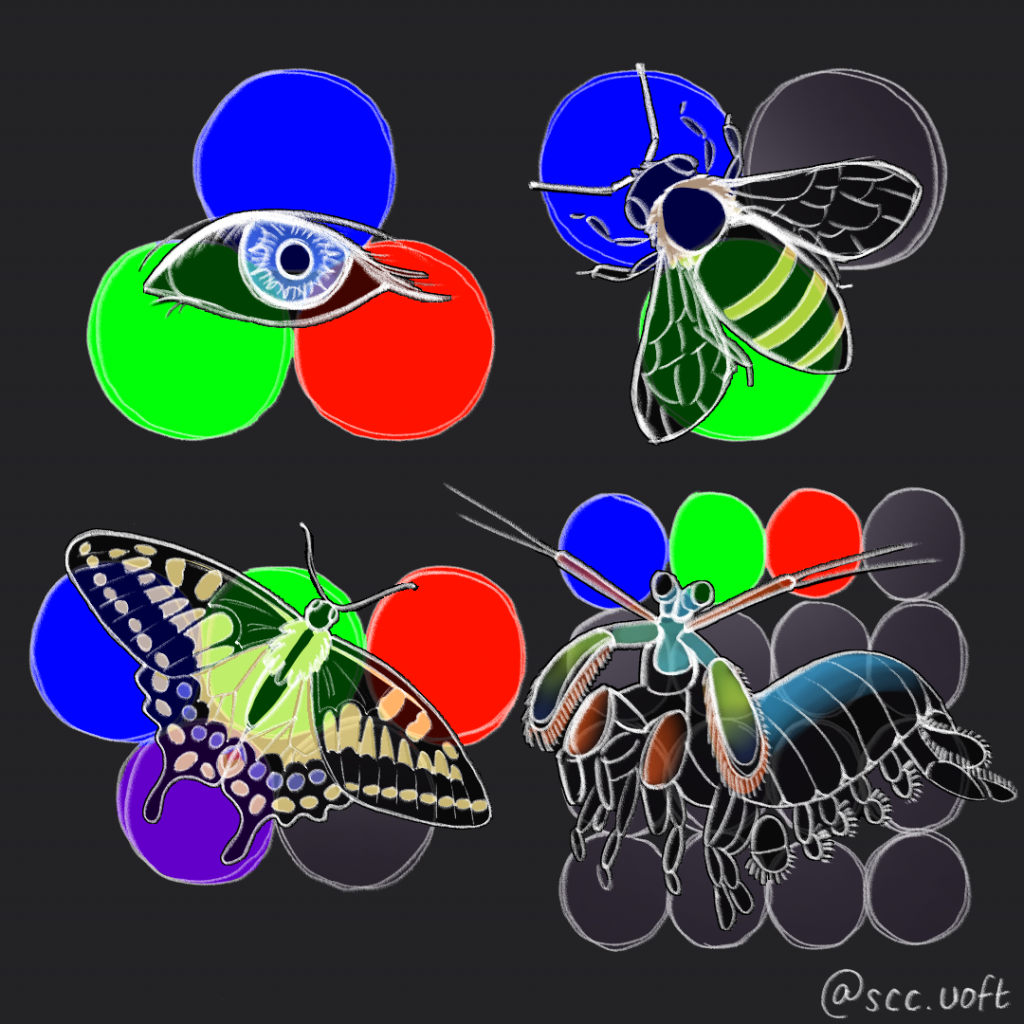
Written by Alexandra Nitoiu
Illustrated by Fiona Tung
If you have a dog, you may know that they don’t see the same colours as humans do. Or maybe you yourself are colourblind, or you know someone who is. Perhaps you’ve even heard about mantis shrimp, and how they can see more colours than humans can. Different animals and individuals have different views of the world—literally. But why do these differences exist? Are there whole worlds of colour that we’re missing out on?
Let’s start with the basics: we see using our eyes, which have cells called photoreceptors that detect different intensities and wavelengths of light. The intensity of light refers to how bright it is, and the wavelength of light determines what colour we perceive. The photoreceptors that detect bright light can also detect colours, and in humans there’s three specific colours that they pick up: red, green, and blue. This means that human eyes are trichromatic. But of course, we don’t just see three colours—we see a whole rainbow! This is because our brain takes all of the signals coming in from different photoreceptors and puts them together. So if red and green photoreceptors are strongly activated while blue ones barely are, the brain determines that the colour we are seeing is yellow.
Colour vision evolved in our ancestors because it was helpful for them. For example, a monkey might be able to see fruit in a tree far away because the fruit is more colourful than the surrounding leaves. And by picking and eating that fruit, the monkey has a higher chance of survival than other monkeys who did not find a fruit. Even though the basic mechanism for vision is the same for many organisms, different eyes evolved separately, so the vision of other species may fundamentally differ from ours.
If we return to man’s best friend—dogs—we learn that they have reduced colour vision because they’re dichromatic. This means that their photoreceptors can only pick up two colours: yellow and blue. However, they have more photoreceptors that work well in dim light than humans do. On the other hand, birds are tetrachromatic, meaning that they have another type of photoreceptor that detects wavelengths in the ultraviolet (UV) range. It turns out that they use this enhanced vision to choose mates, find food, and even decide how to provision food to their chicks! Similarly, honeybees can also see UV light, but their eyes are trichromatic because they don’t have any red photoreceptors.
Then there are other animals whose colour vision is on a completely different playing field: butterflies usually have six or more colour receptors! The Japanese yellow swallowtail butterfly has receptors that include UV, violet, blue, green, and red, and can see differences between colours much better than humans can. So why is this enhanced vision useful? It helps them search for flowers whose nectar they eat! On the other hand, some eyes might not be as spectacular as expected; mantis shrimp have a whopping 12–16 photoreceptor types, but for some reason they don’t detect differences between colours as well as other animals. So what’s the point of evolving such complex eyes? Funnily enough, scientists don’t really know! For now we can only hope that future research holds more answers.
At this point you might be asking, why are humans and some animals limited in their colour vision? Wouldn’t it be better for every organism to see as many colours as possible? To answer these questions we once again have to turn to evolution, which tells us that organisms will only evolve traits that are very beneficial for them. Every cellular process occurring in our bodies takes up some energy. Since we only have limited energy, investing lots of it in vision means we have less energy to use elsewhere. No one animal or organism can do everything, so they focus on improving the traits that are most helpful to them in their current environment. So while we still don’t know what mantis shrimp use their fancy eyes for, we can rest assured that our trichromatic colour vision is just what we need!
Of course, eyes aren’t everything! Your dog may have an easier time fetching yellow or blue toys, and our ability to see the red autumn leaves and sparkling blue ocean certainly makes life more beautiful. But there’s no photoreceptors involved in your cat’s purr when it sits in your lap, or your dog’s boundless joy when it greets you at the door. It turns out that some things in life just need to be felt by the soul!
Sources:
- https://www.colormatters.com/color-matters-for-kids/how-animals-see-color
- https://www.akc.org/expert-advice/health/are-dogs-color-blind/
- https://www.nwf.org/Magazines/National-Wildlife/2012/AugSept/Animals/Bird-Vision
- https://pubmed.ncbi.nlm.nih.gov/28332207/
- https://www.nationalgeographic.com/science/phenomena/2014/07/03/natures-most-amazing-eyes-just-got-a-bit-weirder/